| |
AC Inverters
An AC Inverter is a device that produces 120 volt AC electricity to operate your household appliances by pulling the 12 volt DC power from your RV batteries. This will enable you to use
your big screen TV, toaster, coffee maker, CPAP machine, and even your microwave in your motor home or trailer
without requiring a generator or shore power. Empyreal Solar offers a variety of inverters ranging from light duty 300-600 watt
systems, to heavy duty 2000-3000 watt systems. |
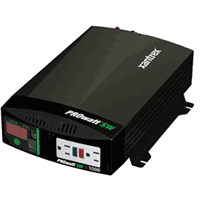 |
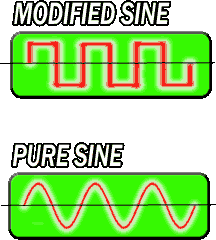 |
Modified Sine Wave vs Pure Sine Wave
There are two different types of inverters to consider when shopping for the right one. Many RVers choose the Modified Sine Wave inverter because of its value over the more expensive Pure Sine Wave Inverter. Modified Sine Wave inverters are less expensive because they produce a simulated AC sine wave that appears to look "square" when viewed on an oscilloscope. Though they will operate your AC devices, the quality of the power is less clean than with a higher quality pure sine inverter. If you are on a tight budget, modified is a viable option.
Pure Sine Wave inverters are superior as they are able to produce a clean AC sine wave which is in some cases better than the power in your home or office. While both types of inverters will do
the same job, the Pure Sine inverter is the most efficient choice. Delicate electronics will benefit largely from a Pure Sine Wave inverter
due to the
clean electricity you will get without distortion. Certain motorized power tools and compressors will only work on pure sine inverters, and the idle power draw while in standby mode draws considerably less power from your batteries. Pure sine inverters are our most recommended choice for your mobile AC power needs! |
|
| |
| |
The Common Misconception between
'Inverters' & 'Converters'
Many people ask about the differences between the duties of an inverter versus a converter as they both
perform similar tasks, but in different ways. Below are explanations of how both of them work. |
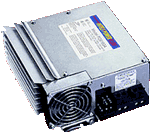 |
Converter: (120 Volt AC to 12 Volt DC)
All RVs include a converter the day it rolls off the lot. It is a required device to have onboard as they are designed to convert 120 volt AC power to 12 volt DC power while plugged into shore power or running a generator. This allows continuous operation of the lights, furnace, fans, and many other 12 volt devices in the RV without using the batteries. A converter also charges the batteries while in operation. |
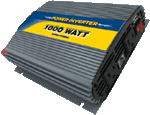 |
Inverter: (12 Volt DC to 120 Volt AC)
An inverter works in reverse, and inverts the 12 volt DC battery power into 120 volt AC power to operate household devices such as TVs, computers, coffee makers, microwaves, and more. Inverters are not usually present in a new RV unless specially ordered to have one installed. They aren't always necessary to have for a simple camping trip as most of the standard RV equipment can run solely on the 12 volt DC battery power. |
Inverters offer incredible freedom when you need household electricity in your RV when the ability to plug into shore power is not available. They can also be a bit costly depending on how much power you require. Operating powerful 120 volt AC devices such as a microwave can be very demanding on the RV batteries, and may require additional batteries to maintain the power draw for any length of time.
Sizes of inverters are important when shopping for the right one. They vary in different wattage ratings starting as low as 60 watts, and can go up to 3000 watts and higher. A simple 100 watt inverter can power a cell phone charger or a laptop computer, where a 3000 watt inverter can power much more demanding devices like coffee makers, hair dryers, computers, Microwaves, and much more. |
|
| |
| |
Inverter/Chargers
An Inverter/Charger includes both types of power switching devices in one standalone package. These powerful units provide an AC Inverter, DC Converter, and an automatic transfer relay built-in to automatically switch from Inverter power to shore power as soon as you plug your RV into a service. Additionally, the built-in converter automatically transfers DC power back to the battery once energized by the shore line service with up to 120 Amp capability! That's one powerful battery charger!
These systems eliminate the extra parts required to integrate a standalone inverter into an RV's electrical system, which in turn cuts down a bit on the installation time.
Inverter/Chargers offer an incredible value and come packed with tons of extra optional features such as battery monitoring, automatic generator start, intuitive and stylish control panels, solar charging controller integration, and much more!
Empyreal Solar offer Inverter/Charger options starting at 2000 watts, and go all the way up to 4400 watt Pure Sine or Modified Sine models. Included is a Digital Remote Control Panel that will be installed inside the coach so you can monitor your power usage and battery voltage, as well as control the extra optional features. |
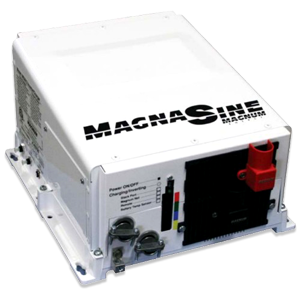 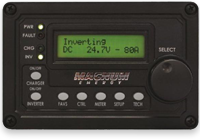 |
|
| |
| |
• What size of inverter should I have?
If you need a simple solution to run a cd player, phone charger, or a laptop, you may want to choose a small inverter ranging from 300 to 600 watts. The higher wattage an inverter is capable of producing gives it greater ability to operate large devices that require a lot of power. For more power-hungry operations like computers, microwaves, and toasters, you may want to consider something in the 1500 to 2000 watt range. For power tools, base heaters, and other high draw devices, you will need something around 2500 to 3000 watts.
• Are my current RV batteries good enough to run an inverter?
In most cases, yes. However the age, strength, capacity, and design of your batteries will vary in performance. Typically, two 6 volt batteries tied in series will perform better than one 12 volt battery for a large inverter. The lead plates inside a battery will determine the performance available for the application. For example, deep cycle batteries tend to have much thicker plates than standard "starting" batteries, and will be able to deliver greater amounts of power for a longer duration. Starting batteries have thinner plates which are ideal for quick bursts of current to start a large motor.
Deep cycle batteries are the best choice for inverters because they have these thicker plates, and can handle more cycles and last longer overall. Additionally, actual size and "Reserve Capacity" or "Amp Hours" are defining factors of what makes a battery acceptable for your application. The higher the Ah or RC rating, the longer the battery will last. The number of batteries you have connected will also increase the amount of time you will get out of your batteries. |
|
| |
|